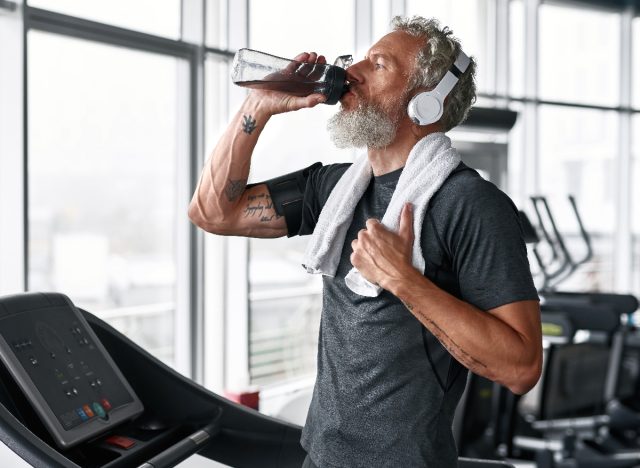If You Can Master These 5 Simple Standing Moves After 60, Your Body Age Is Elite

The true test of youth isn’t the candles on your birthday cake, but more so, it’s how strong, stable, and coordinated you feel when you move. You can’t fake balance or strength as these qualities reveal how well your body has aged, no matter what the number says on your driver’s license.
After 60, every workout should be about quality movement. You want exercises that build control, mobility, and power through the feet, hips, and core. That’s what keeps your joints healthy and your muscles responsive. The right moves can keep your biological age years younger than your chronological age.
Standing movements check all the right boxes. They challenge your posture, train real-world strength, and teach your body to work as one unit. They also protect against falls, boost metabolism, and build lean muscle that supports every daily task.
In this workout, you’ll discover five simple standing moves that reveal the truth about your body age. If you can master these, you’re staying active and proving your body is operating at an elite level for your age.
Goblet Squats
The goblet squat is a master test of lower-body strength, mobility, and posture. Holding a weight in front of your chest forces your core to brace while your hips and knees move through a full, controlled range. It builds leg power, improves hip mobility, and strengthens your back. More importantly, it trains you to sit, stand, and lift with perfect mechanics—skills that keep you strong and capable for decades.
Muscles Trained: Quads, hamstrings, glutes, core, upper back
How to Do It:
- Hold a dumbbell or kettlebell at chest height.
- Set your feet shoulder-width apart.
- Keep your chest tall and push your hips back as you bend your knees.
- Lower until your thighs are parallel to the floor or slightly below.
- Drive through your heels to return to standing.
Recommended Sets and Reps: Perform 3 sets of 10 to 12 reps. Rest for 60 seconds between each set.
Best Variations: Bodyweight squats, pulse squats, goblet box squats
Form Tip: Keep your elbows in line with your knees at the bottom for better depth and posture.
Standing Shoulder Press
The standing shoulder press builds upper-body strength and stability while challenging your balance and posture. Pressing from a standing position forces your core to stabilize your spine and prevents momentum from doing the work for you. It strengthens your shoulders, improves overhead mobility, and teaches your body to generate force through a solid foundation. When you can control the weight overhead with perfect form, your body age is showing elite coordination and control.
Muscles Trained: Shoulders, triceps, upper back, core
How to Do It:
- Stand with your feet hip-width apart and a dumbbell in each hand at shoulder height.
- Tighten your core and squeeze your glutes.
- Press the weights overhead until your arms are straight.
- Slowly lower back to the start position with control.
- Repeat for each rep without arching your back.
Recommended Sets and Reps: Perform 3 sets of 8 to 10 reps. Rest for 60 seconds between each set.
Best Variations: Alternating dumbbell press, single-arm press, banded press
Form Tip: Keep your ribs tucked and your abs tight to protect your lower back.
Kettlebell Deadlifts
The kettlebell deadlift tests strength, mobility, and body awareness in one move. It strengthens your posterior chain—the muscles responsible for power, balance, and posture. The motion teaches you to hinge properly at the hips, which helps prevent back injuries and improves your ability to lift objects safely. Mastering this lift after 60 is proof that your body’s movement patterns are sharp and your muscle coordination is still top-tier.
Muscles Trained: Hamstrings, glutes, lower back, core, forearms
How to Do It:
- Place a kettlebell between your feet.
- Stand tall with your shoulders back and chest up.
- Push your hips back and bend your knees slightly as you reach down.
- Grip the handle firmly and drive through your heels to stand tall.
- Lower the kettlebell back down under control.
Recommended Sets and Reps: Perform 3 sets of 10 reps. Rest for 75 seconds between each set.
Best Variations: Dumbbell deadlift, trap-bar deadlift, Romanian deadlift
Form Tip: Keep the weight close to your body through the entire lift.
Standing Band Pull-Aparts
The band pull-apart trains postural strength and shoulder stability, two areas that often fade with age. It reawakens the muscles that pull your shoulders back and open your chest. Strong upper-back muscles support better breathing, balance, and shoulder health. If you can perform this move with full range and control, your upper body is functioning like someone much younger.
Muscles Trained: Rear delts, rhomboids, traps, rotator cuff
How to Do It:
- Hold a resistance band at chest height with your arms straight.
- Keep your shoulders down and chest tall.
- Pull the band apart by squeezing your shoulder blades together.
- Pause for one second, then slowly return to the start position.
- Maintain tension in the band throughout the set.
Recommended Sets and Reps: Perform 3 sets of 15 to 20 reps. Rest for 45 seconds between each set.
Best Variations: Diagonal band pull-apart, overhead pull-apart, single-arm band row
Form Tip: Lead with your elbows and squeeze your upper back at the end of each rep.
Suitcase Carry
The suitcase carry is a full-body stability challenge disguised as a simple walk. Holding weight on one side forces your core to fire to keep your torso upright. It improves grip strength, spinal alignment, and balance, while strengthening the muscles that protect your lower back. Anyone who can carry a heavy weight with perfect posture shows a level of functional fitness that signals an elite biological age.
Muscles Trained: Core, obliques, forearms, glutes, shoulders
How to Do It:
- Hold a heavy dumbbell or kettlebell in one hand at your side.
- Stand tall with your shoulders even and your core braced.
- Walk forward in a straight line for 30 to 40 feet.
- Switch hands and walk back to the start.
- Maintain an upright posture the entire time.
Recommended Sets and Reps: Perform 3 rounds per side. Rest for 60 seconds between rounds.
Best Variations: Double suitcase carry, offset carry, farmer’s carry with lighter loads
Form Tip: Keep your ribs stacked over your hips and avoid leaning to either side.
The Best Tips for Improving Your Body Age After 60

You can’t control the clock, but you can control how your body performs as you age. These training habits help you keep your biological age running at a much younger pace.
- Move daily: Walk, stretch, and train consistently to keep your muscles and joints active.
- Lift with intent: Focus on slow, controlled reps instead of rushing through sets.
- Train balance and stability: Add single-leg or anti-rotation exercises each week to challenge coordination.
- Prioritize protein: Support recovery and muscle repair with protein-rich meals.
- Sleep and recover: Quality rest restores your hormones and energy levels.
- Stay hydrated: Proper hydration keeps your joints lubricated and your performance high.
- Track your progress: Record your workouts to see real improvements and stay motivated.